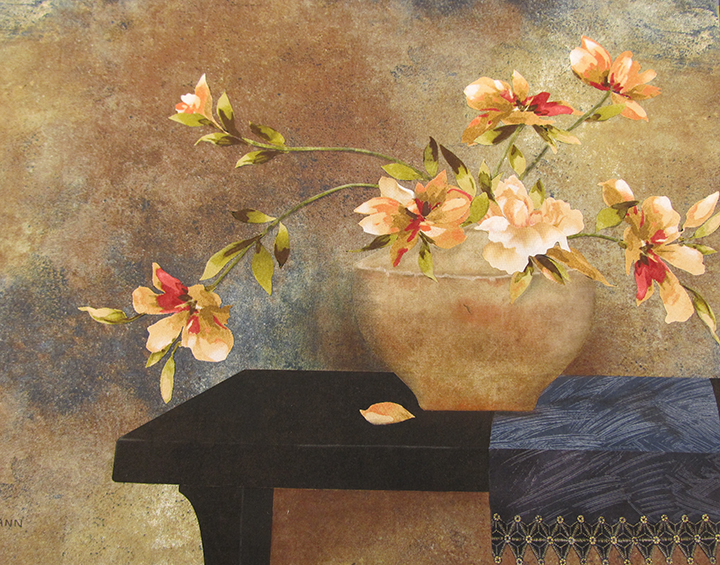Not Your Grandmother’s Quilts: Textile Artist Susan Hoffmann
- Share
- Tweet
- Pin
- Share

When Baileys Harbor resident Susan Hoffmann welcomes a full class of students to her “Landscape Painting with Fabric” session at next weekend’s Madison Quilt Expo, she will do it with full disclosure that she is not, in fact, a quilter.
Instead, Hoffmann prefers the term “textile artist.” Anyone who has seen her painterly landscape fabric creations would certainly agree that her creations are works of art. While she got her start in fabrics during a landscape quilting class, she quickly lost interest in the actual quilting process.
Fortunately for Hoffmann, and the students who would soon follow in her footsteps, she discovered a layering-and-adhesive process that, since 2011, has brought her to teaching opportunities across Wisconsin. In Door County, she has taught at The Clearing in Ellison Bay and Sievers School of Fiber Arts on Washington Island.
Alyssa Skiba (AS): One of the first things you said to me prior this interview is that you don’t consider yourself a quilter.
Susan Hoffmann (SH): No, and I think it’s curious because I spend most of my time with quilters. In 2008, I was dragged by two friends to a landscape quilting class. I discovered in that class that I was not a quilter.
AS: How did you make that discovery?
SH: I couldn’t stand the monotony of the quilting. I didn’t enjoy that part of the process. I loved everything else and when it came to the quilting I just lost interest. During the class I had had several people come up to me, including the instructor, just saying how beautiful my work was and that it actually looked more like a watercolor painting.
AS: Can you describe the first piece you made?
SH: It was a beautiful winter scene from a photo that I had taken on a trip to the Minocqua area and it had snowed but the water had not frozen so the scene was this bright, new snow against this dark, green-black water and I was just so attracted to the contrast in that scene and that’s what I reproduced in my first landscape painting in fabric. When those comments were made to me, I thought, aha! I have a way out of quilting this piece. I can frame it.
AS: Does your process have any similarities to quilting beyond the use of fabric?
SH: Relatively few. What I do is called a raw-edge fabric collage technique, as opposed to traditional quilters who use a sewing machine and piece their fabrics together. Some art quilters will use the collage technique, however, they may machine-stitch or hand-stitch their pieces all together in that layering process and I use an acid-free bonding product.
AS: What is the most challenging part of your process?
SH: Creating perspective and the depth in the scene, and really trying to make fabric look like paint. I freehand cut all of the elements of the scene and my constant challenge is, in the end, I want to convince the viewer of my work that these hard-cut edges actually look like brush strokes.
AS: Is it strange to teach at a quilt expo when you don’t consider yourself a quilter?
SH: I think it’s funny. In fact, besides teaching I am invited by quilt guilds to speak at their programs so I have a little program I put together called, “What Am I Doing Here?” They’re always very curious. At the basis of what I do and certainly what quilters do is the fact that we all love fabric and textiles, so that’s what brings us together. The technique isn’t as important as the fabric itself as the medium.
AS: In your life, how have you seen the role of quilts change?
SH: When I was growing up, everything was more functional. Textiles and fabrics in the home were functional; we sleep on fabric, we wear fabric, we use fabric in our kitchens for cleaning. Quilts were certainly very traditionally used to cover us in our bed. Now they’re hanging on our walls and they’re being given as gifts. They still remain functional but quilting is seen differently. I would be remiss if I didn’t say this: getting to know all these quilters has been a really eye-opening experience. They love what they do and as they continue it they create far more than they can use themselves so the next level would be to give everybody they know gifts and then beyond that, quilters are making quilts for children in hospitals, for veterans, for service members. They are so loving and giving with their talent.
In Door County, Susan Hoffmann is represented by Fine Line Designs Gallery in Ephraim. For more on her work, visit susanstextileart.com.


